Ever since BBMP publicised its proposal for ward delimitation in June, citizens and experts have raised many concerns. Now, the Whitefield Rising Trust has filed a formal objection with the state’s Chief Secretary T M Vijay Bhaskar, against the “unscientific” proposal.
The Trust’s letter, submitted on Tuesday, is also marked to Additional Chief Secretary of the Urban Development Department E V Ramana Reddy, and to BBMP Commissioner B H Anil Kumar.
BBMP’s delimitation exercise will restructure ward boundaries so that Bengaluru’s population is distributed equally across wards, at 42,645 per ward. This population data is based on the 2011 Census.
The Trust points out this data is outdated, and that Mahadevapura’s population has grown in leaps since 2011. So much that the constituency requires a separate municipality for itself, with 25-30 wards, says the Trust in its letter.
Meanwhile, speaking to Citizen Matters, Anil Kumar says that the delimitation proposal is to be placed for BBMP Council’s approval soon, in its upcoming session.
Why is BBMP’s proposal said to be “unscientific”?
As per BBMP’s current proposal, ward boundaries will have to be redrawn based on population in 21 out of the 26 assembly constituencies in the city. Wards will remain unchanged in just five constituencies – Yelahanka, Mahalakshmi Layout, CV Raman Nagar, Basavangudi and Anekal.
Despite the redrawing of ward boundaries, the total number of wards are supposed to stay the same, at 198.
In principle, delimitation is much needed for equitable fund allocation and development of wards. It would reduce the disparity in population between wards, which ranges from 21,171 in Marenahalli to 95,368 in Horamavu as per the 2011 Census.
But in its letter, Whitefield Rising opposes delimitation on two grounds:
- that it is based on 2011 Census data which is “grossly erroneous”
- that the number of wards would stay the same though many wards, especially in constituencies like Mahadevapura, are too large in area

The letter Whitefield Rising Trust submitted on Tuesday
Submitted on behalf of citizen groups in and around Mahadevapura, Whitefield Rising’s letter says there are 5.24 lakh registered voters in the constituency now. Based on the “Election Commission’s approximate thumb rule of 70% of the population being registered as voters”, the Trust estimates the total population of the constituency to be around 7.5 lakhs.
For Mahadevapura, BBMP has proposed increasing the number of wards from eight to 10 during delimitation. Even then, each ward here would have a population of about 75,000, says the letter. This is way higher than the average ward population of around 42,000 that the delimitation exercise targets.
Citizen Matters’ analysis of BBMP’s delimitation proposal too revealed gross miscalculation of the population of some wards, especially those lying outside the Outer Ring Road.
Changing demographics
The UN’s World Urbanization Prospects (WUP) Report 2018 estimated that Bengaluru’s population would be 1.18 crore in 2019. The city’s population was 96.2 lakh as per the 2011 Census, and 65.3 lakh as per the 2001 Census.
Considering data from both WUP and the Census, it is obvious that population has been increasing exponentially here.
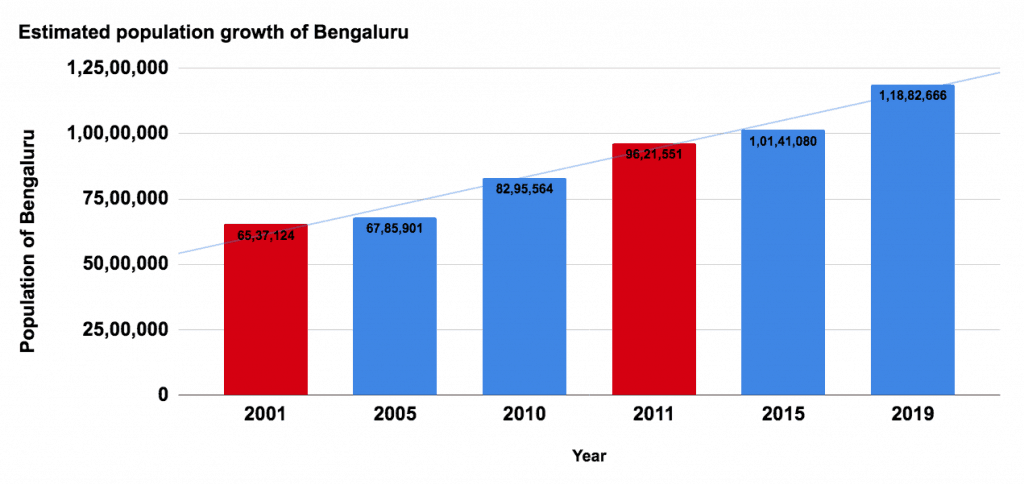
The red bars are based on 2001 and 2011 Census. Blue bars are estimates from UN’s WUP report 2018
What is also evident is that delimiting ward boundaries based on demographic data that’s almost a decade old, is unscientific.
Demographic changes in constituencies
Apart from an increase in the overall population, in certain localities the population increased at a significantly higher rate than in other parts of the city.
According to BBMP’s delimitation proposal and the Census data, between 2001 and 2011, population increased in assembly constituencies outside the Outer Ring Road (ORR) while those inside the ORR have seen little or negative growth.
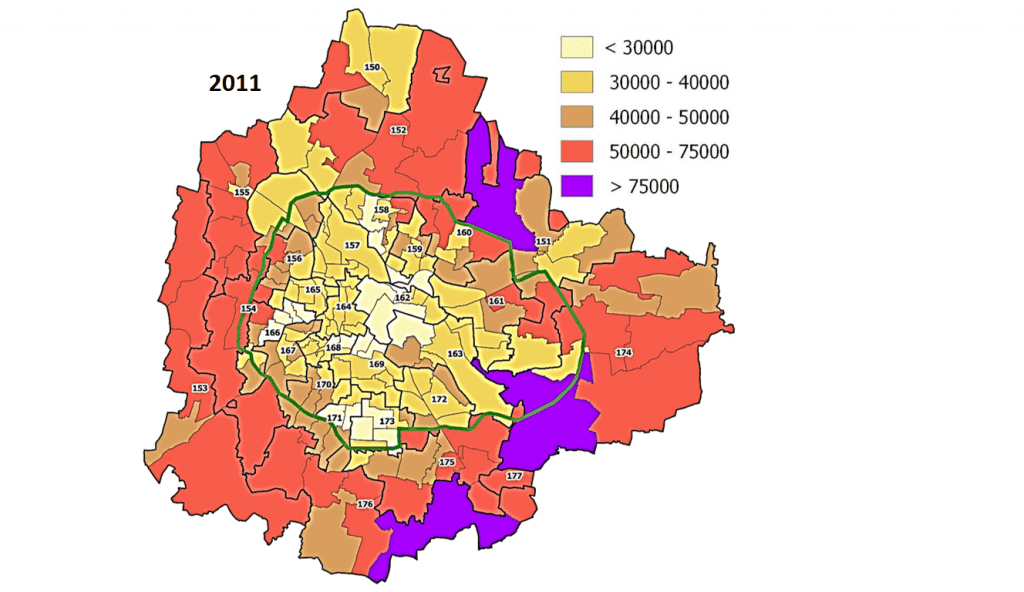
Population growth in assembly constituencies between 2001 and 2011.
For example, Shivajinagar and Chickpet assembly constituencies saw negative growth between 2001 and 2011, whereas Yeshwanthpura, Bengaluru South, Bommanahalli and Mahadevapura constituencies saw increase of more than 100 per cent. While Yeshwanthpura’s population increased by 162 percent, Bengaluru South’s population increased by 156 percent and Mahadevpura’s increased by 140 per cent in that decade.
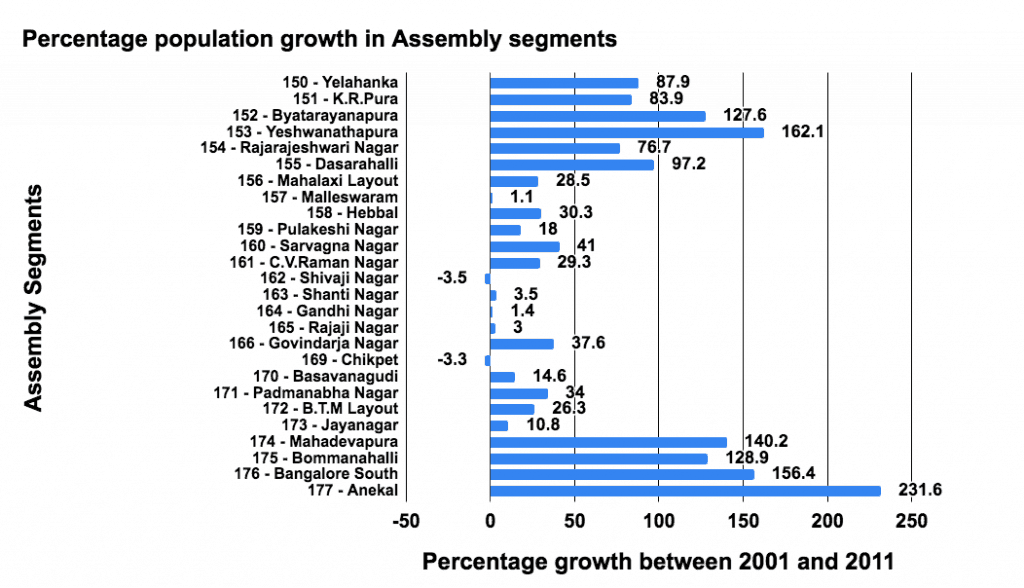
In 2011, the 132 wards in core areas only had average population of 37,262 each. In contrast, average population in the 66 wards in outer areas was way higher, at 53,410 each.
To iron out this imbalance, BBMP proposes to change ward boundaries so that each ward would have population of 42,645. The number of wards in core areas would then reduce from 132 to 115. Whereas in outer areas, the number of wards would increase from 68 to 83.
What’s wrong with BBMP’s proposal: The Mahadevapura example
Mahadevapura assembly constituency currently has eight wards spread across almost 115 sq km. In 2001, the constituency’s population was 1.79 lakh, with average of 22,480 people in each ward. However, by 2011, its population more than doubled, to 4.4 lakh. With this, the average population in wards here increased to 53,997.
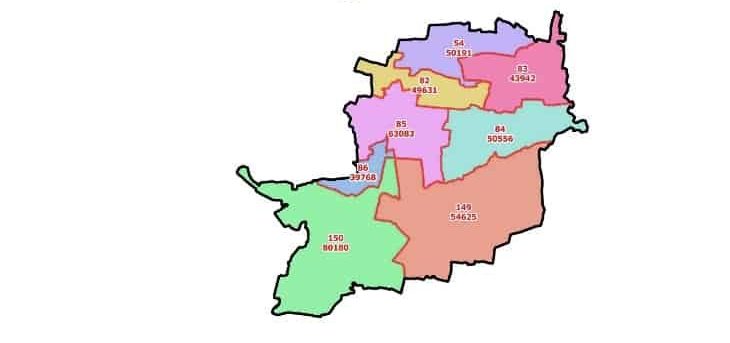
Wards in Mahadevpura Assembly Constituency as it is today.
BBMP has proposed to add two more wards to this constituency during delimitation. It has proposed two plans for delimiting ward boundaries.
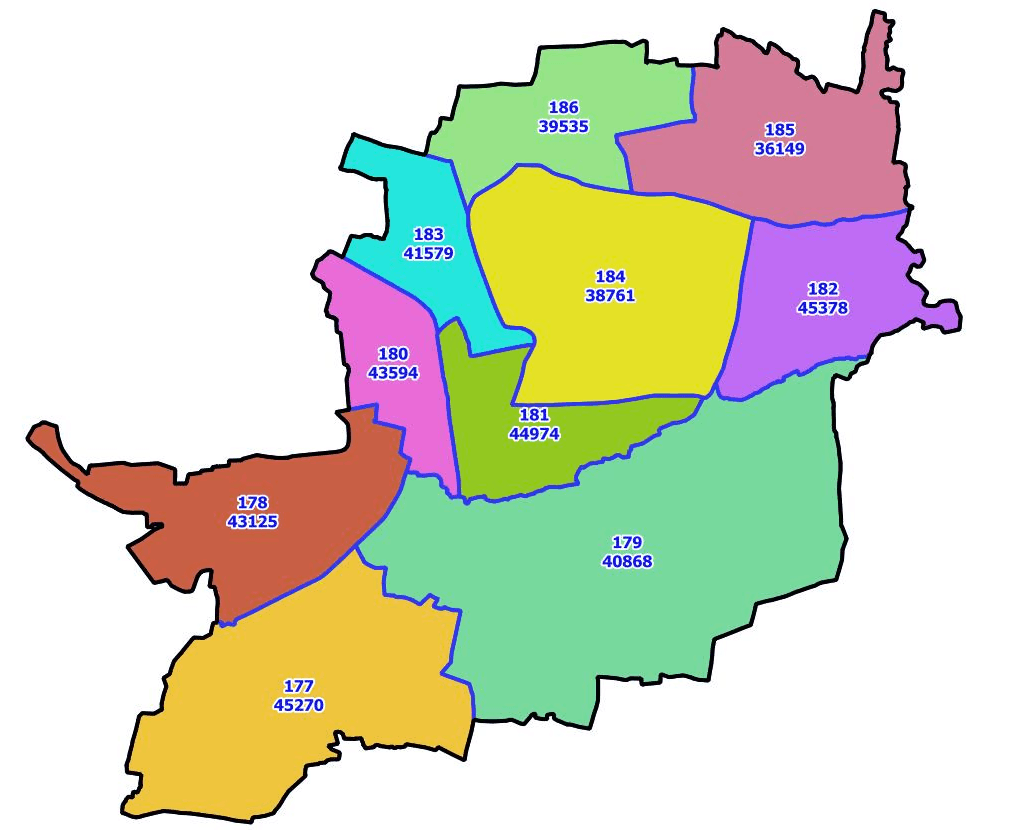
One of the proposals for delimitation of ward boundaries for Mahadevpura
As per these, the eight existing wards — Varthuru, Bellanduru, Hudi, Garudacharpalya, Kadugodi, Hagadur, Dodda Nekkundi and Marathahalli — would all have an average population of little more than 42,000. Both the proposals have kept the average population of Varthuru and Hagadur wards at over 45,000, which is more than the targeted average.
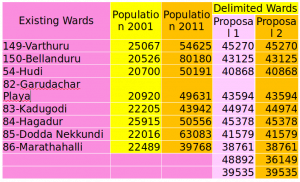
Population distribution in 10 (8+2 new) wards in Mahadevpura
Mahadevapura in reality
The voter count for 2019 Lok Sabha election shows that Mahadevapura assembly constituency had 5.01 lakh voters as of this January – 2.7 lakh male, 2.2 lakh female, and 157 transgender voters. Though voter rolls may have some false entries, it is indicative of the constituency’s population.
Even if 5.01 lakh is considered as the constituency’s total population, each ward here would have average population of over 50,000. This is almost 8000 more than the 42,645-limit set by BBMP.
However, the actual population of the constituency would be way higher, as mentioned in Whitefield Rising’s letter to the Chief Secretary. It would include those who are not in the voter rolls as they’re below 18, and the floating population who are not registered as voters.
Why the demand for a separate Mahadevapura municipality?
“Mahadevapura has grown so much in a matter of few years, that we are asking for a separate municipality with at least 30,000 citizens in each ward, so that we get proper local representation,” says Anjali Saini of Whitefield Rising.
The whole idea behind the 74th amendment, Anjali says, was for wards to have proper local representation in the “urban panchayath raj”. “But if you have a ward of 24 sq km area with 1 lakh population, what is local about it?” she asks.
The following data, taken from the Whitefield Rising’s letter, shows that most wards in Mahadevapura exceed 10 sq km while many other wards have area less than 1 sq km.
Wards in Mahadevapura
| Ward number | Ward name | Area in sq km |
| 54 | Hoodi | 15.3 |
| 82 | Garudachar Palya | 6.8 |
| 83 | Kadugodi | 11.88 |
| 84 | Hagaduru | 12.68 |
| 85 | Doddanekkundi | 12.12 |
| 86 | Marathahalli | 3.10 |
| 149 | Varthur | 26.98 |
| 150 | Bellanduru | 26.37 |
| Total area | 115.23 |
Some other wards in the city
| Ward number | Ward name | Area in sq km |
| 15 | Dasarahalli | 0.88 |
| 30 | Kadugondanahalli | 0.71 |
| 31 | Kushaal Nagar | 0.65 |
| 48 | Muneshwara Nagar | 0.48 |
| 49 | Lingarajapura | 0.89 |
Voices from the council
“Delimitation can help corporators finish work faster, depending on funds they get from the government,” she says, adding, if the ward is big and disproportionately distributed, people may ask corporators why the adjacent ward is developing and not theirs.
Shwetha Vijaykumar, the BJP corporator of Doddanekundi, says delimitation exercise would definitely benefit wards since there’d be proper distribution of funds based on the population. But she is wary that her ward will be “broken into several pieces” and affect her performance in the upcoming elections.
Besides, “we will push for a delimitation exercise which will be grounded in reality and not on outdated data. We are going to object the proposal to divide the wards based on 2011 population as this will not solve anything,” she says.